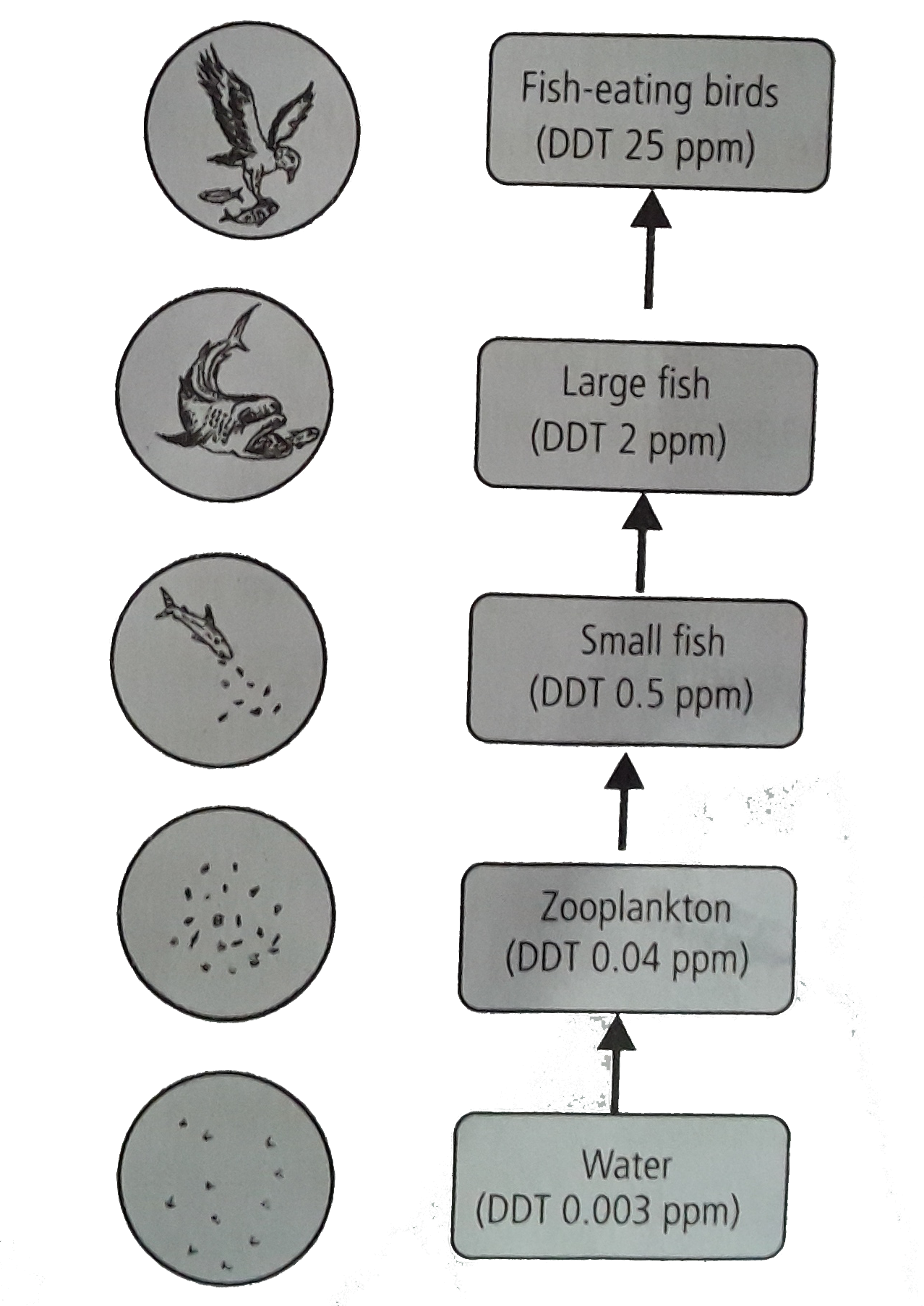Find the correct order of biomagnification of DDT in an aquatic food chain:
Water -0.003 ppm, zooplankton -0.5 ppm, small fish -0.04 ppm, large fish -2 ppm , fish eating birds -25 ppm
Water-0.003 ppm , zooplankton-0.04 ppm, zooplankton -0.5 ppm , large fish -2ppm, fish eating birds -25 ppm
Water-0.003 ppm, small fish-0.04 ppm, zooplankton-0.5 ppm, large fish-2 ppm, fish eating birds -25 ppm .
Water-0.003 ppm, fish eating birds-25 ppm, zooplankton -0.5 ppm , small fish -0.04 ppm, large fish -2.5 ppm
The correct Answer is:B
Step by step video & image solution for Find the correct order of biomagnification of DDT in an aquatic food chain: by Biology experts to help you in doubts & scoring excellent marks in Class 12 exams.
Related Playlists
- BOOK - DINESH PUBLICATION ENGLISHCHAPTER - ENVIRONMENTAL ISSUESEXERCISE - Check your grasp18videos
ENVIRONMENTAL ISSUES
- BOOK - DINESH PUBLICATION ENGLISHCHAPTER - ENVIRONMENTAL ISSUESEXERCISE - Brain teasers-X145videos
ENVIRONMENTAL ISSUES
- BOOK - DINESH PUBLICATION ENGLISHCHAPTER - ECHINODERMATAEXERCISE - REVISION QUESTIONS65videos
ECHINODERMATA
- BOOK - DINESH PUBLICATION ENGLISHCHAPTER - EVIDENCES OF EVOLUTIONEXERCISE - CHECK YOUR GRASP19videos
EVIDENCES OF EVOLUTION
Similar Practice Problems
- Question 1 - Select One
Given figure represents biomagnification of DDT in an aquatic food chain. Select the incorrect statement regarding this.
 AWhen agricultural fields are sprayed with DDT, it is carried by runoff water into nearby aquatic bodies.BRiver water may have a very low concentration of DDT, but the carnivorous fish in that river may contain high concentration of DDT, which is still suitable for consumption by huyman beings.CIncreased concentration of DDT in birds affects calucium metabolism due to which egg shells become thin and break before maturity.DNone of these
AWhen agricultural fields are sprayed with DDT, it is carried by runoff water into nearby aquatic bodies.BRiver water may have a very low concentration of DDT, but the carnivorous fish in that river may contain high concentration of DDT, which is still suitable for consumption by huyman beings.CIncreased concentration of DDT in birds affects calucium metabolism due to which egg shells become thin and break before maturity.DNone of these - Question 1 - Select One
Which of the following statements is not correct regarding biomagnification ?
(i) Mercury accumulated by an organism cannot be metabolised.
(ii) In the process of biomagnification, concentration of DDT is increased at successive trophic levels.
(iii) Accumulation of cadmimu can cause thinning of egg shell in birds.
(iv) DDT accumulation is a major cause of reduced population of fish eating birds.
(v) Biomagnification occurs only in aquatic food chain.A(i), (iii) and (v)B(iii) and (iv)C(iii) and (v)D(i), (ii) and (iv)
Similar Questions
With the help of a flow chart, show the phenomenon of biomagnification of DDT in an aquatic food chian.
View SolutionThe range of biomagnification of DDT in an aquatic food chain, if starting from 0.003 ppb level in water may go at fish-eating bird level upto
View Solution(a) What depletes ozone in the stratosphere? How does this affect human life?
(b) Explain biomagnification of DDT in an aquatic food chain. How does it affect the bird population?View SolutionGrazing food chain
View SolutionWhat is a food chain?
View SolutionThe order of all organisms in an aquatic food chain is
View SolutionDetritus food chain.
View SolutionBiomagnification of DDT caused decline in bird population by:
View Solution

